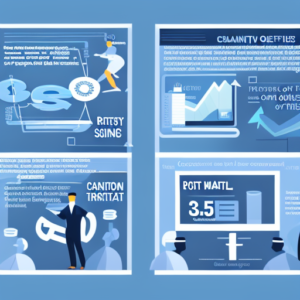As a business owner or manager, you must have a solid understanding of your company’s financial performance. One of the key financial statements that can provide valuable insights into your organization’s profitability is the profit and loss statement (P&L), also known as the income statement. Analyzing a P&L effectively can help you identify revenue and expense trends, evaluate cost structures, and make informed business decisions.
This blog post will guide you through analyzing a P&L like a CFO. We will cover the key components of a P&L statement, explain important ratios and metrics, and provide actionable insights to help you leverage your financial data effectively. So, let’s dive in!
Understanding the P&L Statement
A profit and loss statement summarizes the revenues, costs, and expenses incurred by a business over a specific period, usually a month, quarter, or year. It provides an overview of your company’s ability to generate profits by increasing revenues, managing costs, and controlling expenses. Here are the key components you’ll find in a P&L statement:
1. Revenue
Revenue represents the total income generated from selling goods or services during the specified period. It includes all sales, discounts, returns, and allowances. Understanding your revenue breakdown can help identify your most profitable products or services and areas for potential growth.
2. Cost of Goods Sold (COGS)
The cost of goods sold represents the direct costs of producing or delivering your products or services. This includes the cost of materials, direct labour, and manufacturing or production overheads. Analyzing your COGS can provide insights into your production efficiency and help you evaluate pricing strategies.
3. Gross Profit
Gross profit is calculated by subtracting the COGS from the revenue. It reflects the profitability of your core business operations before accounting for operating expenses. Monitoring your gross profit margin can reveal your pricing models’ effectiveness and efficiency in managing production costs.
4. Operating Expenses
Operating expenses include all the costs of running your business, such as rent, utilities, salaries, marketing, and administrative expenses. Analyzing your operating expenses can reveal areas where you can reduce costs or allocate resources more effectively.
5. Operating Profit (EBIT)
Operating profit, or earnings before interest and taxes (EBIT), is the profit generated from your core business operations after deducting COGS and operating expenses. It measures your company’s profitability before considering interest expenses and taxes.
6. Net Profit
Net profit, also called the bottom line, represents the profit remaining after deducting all expenses, including interest and taxes. It indicates your company’s overall financial performance and the profit you retain.
Key Ratios and Metrics for P&L Analysis
While understanding the components of a P&L statement is crucial, it’s equally important to analyze key ratios and metrics to gain deeper insights into your company’s financial health. Here are some essential ratios and metrics you should consider:
1. Gross Profit Margin
Gross profit margin measures the percentage of revenue after accounting for the cost of goods sold. It indicates how effectively your company generates profit from its core operations. A higher gross profit margin is generally favourable as it suggests efficient cost management and pricing strategies.
Formula: (Gross Profit / Revenue) x 100
2. Operating Profit Margin
Operating profit margin measures the percentage of revenue after deducting all operating expenses but before interest and taxes. It indicates the profitability of your core business activities. A higher operating profit margin signifies that your business is generating enough profit to cover operating costs, which is typically a positive sign.
Formula: (Operating Profit / Revenue) x 100
3. Net Profit Margin
Net profit margin represents the percentage of revenue that converts into net profit after accounting for all expenses, including interest and taxes. It helps gauge the overall profitability of your business. A higher net profit margin indicates better financial efficiency and effective cost control.
Formula: (Net Profit / Revenue) x 100
4. Return on Investment (ROI)
Return on investment determines how effectively your company generates profits based on the capital invested. It measures the return you receive for each dollar invested. A higher ROI indicates better profitability and efficient use of resources.
Formula: (Net Profit / Total Assets) x 100
Actionable Insights for P&L Analysis
Now that you understand the key components and metrics used for P&L analysis let’s explore some actionable insights you can gain from analyzing your P&L statement:
- Identify Revenue Trends: Analyze revenue trends over time to identify periods of growth or decline. This can help you adjust your sales and marketing strategies accordingly.
- Evaluate Cost Structures: Assess your COGS and operating expenses to identify areas where you can reduce costs, negotiate better deals with suppliers, or optimize your resource allocation.
- Compare Profit Margins: Compare your gross profit margin, operating profit margin, and net profit margin with industry benchmarks to assess your company’s financial performance relative to your competitors.
- Monitor Key Ratios: Regularly monitor key ratios and metrics like gross profit margin, operating profit margin, and net profit margin to identify any sudden changes or areas for improvement.
- Conduct Scenario Analysis: Perform scenario analysis by adjusting revenue and cost assumptions to assess the impact on your profitability. This can help you make informed decisions and develop future strategies.
- Utilize Technology: Embrace accounting software or financial management platforms that provide real-time visibility into your P&L statement. This ensures accurate and up-to-date insights for better decision-making.
By leveraging these actionable insights, you can optimize your financial performance, make informed business decisions, and drive sustainable growth for your company.
Conclusion
Analyzing a P&L statement like a CFO requires a deep understanding of the key components, ratios, and metrics. By studying revenue trends, evaluating cost structures, and monitoring key ratios, you can gain valuable insights into your company’s financial health and make informed business decisions.
Remember, P&L analysis is an ongoing process, and regular monitoring and adaptation are crucial for maintaining financial stability and driving profitability. So, make it a habit to analyze your P&L regularly, adjust your strategies accordingly, and watch your business thrive.
Disclaimer: The information presented in this blog post is for educational purposes only and should not be considered financial advice. Always consult a qualified financial professional for personalized guidance tailored to your situation.
4 thoughts on “How to Analyze a P&L Like a CFO: A Comprehensive Guide”
Leave a Reply
You must be logged in to post a comment.





[…] Managing outgoing payments is as important as getting paid quickly. Negotiate longer payment terms with suppliers when possible. This doesn’t mean delaying payments arbitrarily, but rather aligning payment schedules with your cash flow cycles. Use technology to your advantage – many accounting software platforms can help you track due dates and optimize payment timing. Some businesses have improved their cash position by implementing a centralized procurement system, which can lead to better supplier terms and reduce costs. […]
[…] of these efficiency components. The next section will explore various methods and metrics used to evaluate financial efficiency in […]
[…] each stakeholder group, considering their expertise and interest in the project. When communicating financial data to non-financial stakeholders, use visual aids and simplified explanations to make the information […]
[…] These three elements – skilled and diverse talent, clear goals and KPIs, and a commitment to continuous learning – form the core of high-performance finance teams. However, to truly excel, teams must also leverage technology effectively. In the next section, we’ll explore how cutting-edge tools and systems can propel finance teams to new heights of efficiency and strategic impact. […]